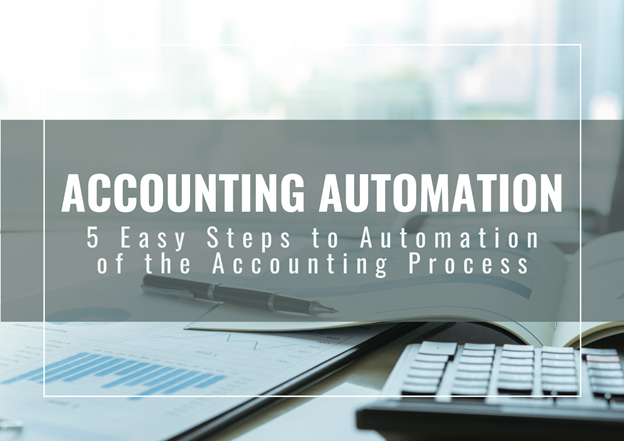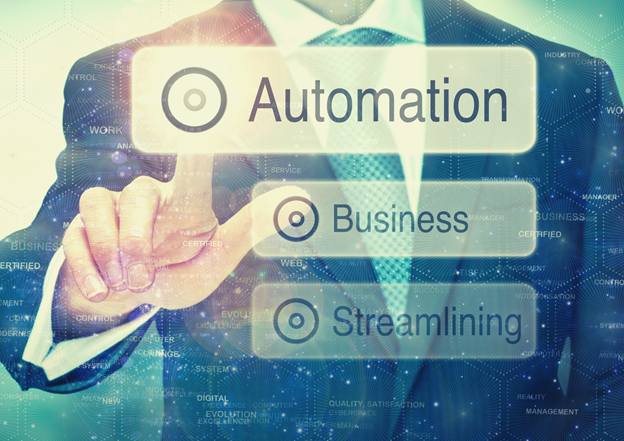Automation of the Accounting Process

Companies spend hundreds of hours every year trying to find out how to manage and keep track of their money. It’s stressful for business owners to think of the time, money, and effort they put into daily status reports, monthly financials, and yearly tax preparations. Artificial intelligence in accounting software, pre-accounting tools, and robotic process automation (RPA) optimize how transactions flow through systems. Do you want to take advantage of this improved automation? You’ll learn how with our 5 Easy Steps to Automation of the Accounting Process.
One can get to know about automation testing with the help guides found online. Automation testing paved the way for implementing automation in business processes. Repeatable business process workflow adds value to each step of the process.
However, we can’t automate every single business process. But some operations are perfect for automation. Luckily for business owners, bookkeeping, tax computations, and accounting are just some of these processes.
The Benefits of Automating Accounting
Businesses often make use of accounting software programs to automate accounting tasks. These computer programs can do in a minute what an average person can do in a day. With the correct data inputs, you can make complex reports within minutes or seconds. You may not even need to touch a calculator to get your work done.
There’s a long list of benefits to automating business processes like bookkeeping and tax calculations. But, before we dive into how you can automate accounting, let’s take a quick look at why you should turn to automation.
Automation Saves Time
In most businesses, saving time equates to saving money. For example, suppose an accountant uses a software program that helps them crunch the numbers and prepare a report. What used to take the whole day will now take them less than an hour.
There may be minimal reconciliation needed. The accountant only needs to double-check what the system prepared. Confirming the classifications are right, and that the system has posted transactions in the right account initially while remaining in balance are the critical steps. Pre-accounting tools like Vic.ai or Dext are currently doing this type of work. The accountant can then spend the rest of their day doing more productive tasks.
Automation Reduces Human Error
Even the best accountants make mistakes. If you catch the error early, the worst that can happen is you spend a few more hours rectifying the mistake. But accounting blunders can be costly. Automation reduces human errors, making way for more accurate reports and calculations.
Learning how to utilize automation properly for accounting tasks can help streamline business processes. Making sure your automated processes are correctly working is key to ensuring the accuracy of your reports.
But, whether you’re planning to optimize your existing accounting program or you’re looking at the top accounting software systems in the market, it’s best that you also learn automation testing. Learning automation testing allows you to check whether your automation efforts are working and how well they’re performing to achieve your goals. Automation testing also helps ensure the accuracy of your reports and the reliability of your data.
Automation Boosts Productivity
You’re more productive when you can perform more tasks in a shorter amount of time. It’s the exact meaning of productivity. So external, contracted, or freelance accounting professionals who get billed by the hour may start to think that automated accounting will take their jobs away. News flash: It could be the complete opposite.
When you learn to make computer programs work for you, you can get more things done for more clients with less effort. You even free up your schedule for something you’re more useful for — like guiding clients and helping them manage and grow their financial wealth. If you have built a Client Accounting Services (CAS) practice, you can add Advisory Services for greater client satisfaction.
5 Steps to Automating the Accounting Process
The transition from manual processes and Excel files to automated accounting systems may be difficult. It’s no small change you’re planning to undertake here. But it doesn’t have to be so complicated. So, are you ready to take your first step into accounting automation? Here are the five easy steps to get you from manual to automated accounting:
Step 1: Know Where You Stand
How much of a change you can expect depends on where you currently stand in terms of accounting processes. For example, how much of your accounting is done manually, and how much of it can be automated?
This task may take you a while, but you need to understand how the people involved in accounting processes do their jobs. These aren’t just your junior and senior accountants. First, you need to list all the tools that you currently use, who uses them, and what you use them for.
For example, you might be using Excel for budgeting, forecasting, and expense management. The finance department, accounting department, and finance manager use Excel for one or more of these functions.
On the other hand, payroll managers and junior accountants may be using another software for payroll management. Therefore, if secondary tools are required for any core accounting tool to function, you should include them in the list.
Step 2: Choose an Accounting System
Now that you know your business needs, you’ll be able to choose an accounting system that works for your business. Full automation of accounting processes can take you a considerable amount of time and money to implement. Still, implementing a new accounting system may prove to be the best course for your business.
Consider your accounting goals, your budget, and your workforce when you’re choosing a core accounting system. Aside from the basic features, it would help to consider security features, customer support, automation integration, and user experience.
Step 3: Migrate Your Data
After you’ve chosen a core accounting software system, the next step is to start data migration. Data migration plans should help you identify what and how much data needs to be transferred. You might also need to put older data into archives.
This step should also allow everyone involved in the accounting process to adjust to the new system. Training should be provided to employees. Primary users should learn the best way to navigate the system because they will work with it more often than any other employee.
Adjustment can take weeks or months, depending on how much of a change you’re implementing. However, by the end of the adjustment period, primary users of this core system should already be confident in the automation performing basic and complex accounting tasks.
Step 4: Automate, Test, Integrate
As time passes, you get fewer questions from your core users. The reduction in questions occurs because they have become familiar with the features and already know how to use the accounting system. However, your secondary users may be having problems. They may have even found other manual tasks to automate. It is at this point that you can add pre-accounting tools and robotic process automation (RPA).
An accounting system that isn’t customized for your business is doubtful to serve as an all-in-one solution. However, it’s typical for business owners who already use an off-the-shelf accounting system to integrate additional automation functions.
Businesses rarely use just one system for all their financial management needs. While you already have a core accounting system, you may want to utilize additional tools to help your employees. In addition, some accounting systems allow automation integrations. As always, automation testing should be performed before any of these functions deal with any actual data.
Step 5: Monitor
Monitoring your systems and making sure that they’re working as they should is key to maintaining accurate and reliable accounting. In addition, you should observe the following results of automating your accounting process:
- Data reports are more accurate, and there are fewer accounting errors.
- Accounting teams are more efficient and productive. They should be spending less time generating results and more time performing analysis.
- Redundancies are found, and accounting processes are optimized.
You should be seeing an increase in the quality of work produced, an increase in employee productivity, and a decrease in human errors. In other words, the business should now benefit from automating the accounting process.

Conclusion
Automating accounting isn’t an easy feat, but doing so can help businesses save time, money, and effort. In addition, it boosts productivity and greatly reduces human error, and these benefits apply to freelance and remote accountants. With the 5 Easy Steps to Automation of the Accounting Process, you have a formula to make your processes easier and automated.
Accounting automation isn’t just about choosing the most expensive or the most popular accounting system in the market. Instead, it’s about knowing where you stand and choosing an automated accounting system that helps you achieve your goals.
Learn more about emerging technologies, RPA, and accounting software with K2 CPE courses.